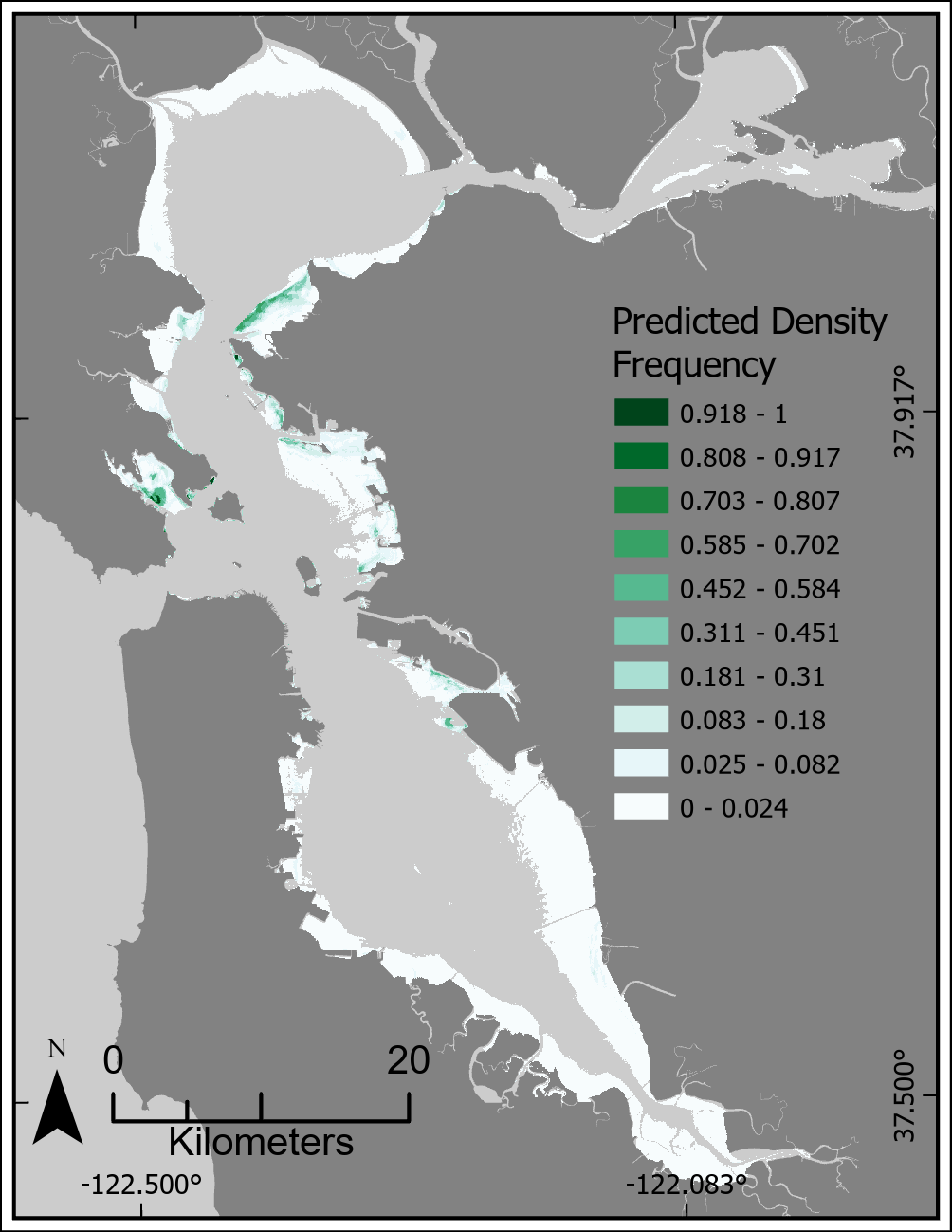Explore the San Francisco Bay Eelgrass Habitat Suitability Model.
Habitat models are important tools in the conservation, management, and restoration of species. Seagrasses (a photosynthetic flowering plant found in salty and brackish waters) have been a major target of restoration and conservation globally. Among them, Eelgrass (Zostera marina) is distributed in temperate bays and estuaries across the northern hemisphere and forms dense beds providing habitat and resources for fish, invertebrate and bird species. It also provides an important substrate for herring spawning which in turn supports dozens of bird species including migratory birds like Scaup and the Surf Scoter. Healthy eelgrass beds are a keystone of climate resilient bays mitigating climate impacts through ameliorating impacts of ocean acidification, anchoring shorelines and sediments, dampening waves and carbon storage.
In California, an estimated 20% of the state’s eelgrass is located within San Francisco Bay. The bay is believed to hold the greatest potential capacity for eelgrass restoration in the state while concurrently hosting some of the most dynamic eelgrass beds due to a host of differing stressors. Audubon and partners Dr. Katharyn Boyer (Estuary and Ocean Science Center, San Francisco State University), Keith Merkel and Whelan Gilkerson (Merkel & Associates), developed new models to predict the distribution and quality of habitat for eelgrass to inform climate smart restoration, conservation, and management in San Francisco Bay.
The team build on work previously conducted a decade ago by Merkel & Associates and incorporated new data, hydrologic and remote sensing models along with multiple San Francisco Bay-wide eelgrass surveys into new modeling frameworks. These models focused on current habitats as well as potential future scenarios.
To assess current habitat (Figure 1) the team used the three bay-wide eelgrass surveys to assess density-frequency (or persistence over time). Together with bay-wide distribution information on light saturation, temperature, salinity, desiccation, wave height and water flushing time derived from new data sources, hydrologic and remote sensing models, a Random Forest model framework was used to create a habitat suitability model of current climate conditions. This model predicts the density-frequency of eelgrass as an estimate of habitat quality across the San Francisco Bay.

Future climate conditions are likely to include increased extreme events such as marine heat waves and increased seasonal runoff contributing to lower salinity in San Francisco Bay. Future conditions will also include sea-level rise. To assess the potential impacts of climate stressors on eelgrass the team incorporated climate projections and extreme event scenarios into model inputs and a maximum entropy modeling framework to predict potential changes in eelgrass habitat. These future scenario models predict changes in eelgrass habitat due to changes in sea surface temperature, bay salinity, and sea-level rise. The team produced separate models for each scenario (Figure 2); increased temperatures, decreased salinity, and increased sea level. In each case the percent change in probability of occurrence of eelgrass was assessed as a measure of impact to eelgrass habitats in San Francisco Bay.
Many traditional habitat suitability models predict the probability of occurrence of a species in a given area. These approaches don’t account for demographic information about the species such as persistence and extinction. These models predict the persistence and density of eelgrass across San Francisco Bay and then looks at the probability of its occurrence under different future climate related scenarios. They go beyond explaining where eelgrass may be likely to occur and explain where eelgrass is likely to thrive. These models are valuable for informing conservation efforts, management, and restoration of eelgrass in San Francisco Bay by illustrating where eelgrass is most likely to thrive now and where it may persist in the future.

For more information contact Daniel Orr, Audubon California, Director of Geospatial Science (Daniel.Orr@audubon.org)
Project Team: Daniel Orr and Paige Fernandez (Audubon California), Dr. Katharyn Boyer (Estuary and Ocean Science Center, San Francisco State University), Keith Merkel and Whelan Gilkerson (Merkel & Associates).
Project Status:
This project is completed, and manuscripts are in progress to be submitted for publication.
Next Steps:
This work is needed in 4 additional California estuaries that together with San Francisco Bay contain an estimated 80% of California’s eelgrass.
Project Acknowledgements:
This modeling work was supported in full by the California Ocean Protection Council with pre-project funding from the Resource Legacy Fund. We would like to thank all who participated in Technical Advisory Committee and Technical Stakeholder Committee meetings. The modeling itself has been built upon years of contribution to bay-wide eelgrass surveys, restoration, research, and eelgrass management within San Francisco Bay that has been supported through funding and collaboration by many parties over nearly three decades. Without this underpinning work, the present modeling would not be possible. Generous support for most of the eelgrass work in the bay has been provided by NOAA’s National Marine Fisheries Service and Restoration Center, California State Coastal Conservancy, US Army Corps of Engineers, Environmental Protection Agency, Cosco Busan Trustee Council, California Ocean Protection Council, California Department of Transportation, San Francisco Bay Conservation and Development Commission, San Francisco Estuary Partnership, Marin Community Foundation, and Richardson Bay Regional Agency.
More from Audubon about eelgrass.
New eelgrass habitat model to supercharge conservation efforts to prevent acidification, erosion, and other climate change impacts in major CA bays
Postponement of Ventura's Christmas Bird Count
Our newsletter is fun way to get our latest stories and important conservation updates from across the state.
Help secure the future for birds at risk from climate change, habitat loss and other threats. Your support will power our science, education, advocacy and on-the-ground conservation efforts.
California is a global biodiversity hotspots, with one of the greatest concentrations of living species on Earth.